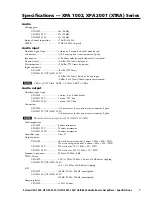
Insider’s Secrets
_____________________________________________________________
12
And reviewer George Shilling, writing for
Resolution
magazine in their May/June 2003 issue, said,
“The [6176 preamp] section is everything I remember about the 2-610—a big warm, clear character,
enhancing beautifully. Doing a last-minute vocal on a long project where several vintage channels of
the grey-blue variety had been used for the bulk of recording, the vocals suddenly came to life with an
extra sparkle when using the 6176 as a recording channel. It was noticed immediately by all present,
after finding the optimal of the two input impedance settings... The ability to juggle the two gain
controls for a variable amount of [tube] drive is a bonus, enabling the user to vary the tone subtly.”
The compressor section of the 6176, of course, is based on
the 1176, long known by engineers to be an essential tool
in recording vocals. Industry legend Andy Johns (Led
Zeppelin, Rolling Stones) says flatly, “For vocals there
really isn’t a better compressor.” Bruce Swedien is another
legendary engineer who is a die-hard 1176 fan. “I love
them on vocals,” he says. “All of the Michael Jackson and James Ingram vocals that everyone has
heard so much were done with at least one of those 1176s. I couldn’t part with them for anything.
They sound fabulous.”
Added reviewer Hugh Robjohns, writing about the Universal Audio 1176LN reissue in
Sound on Sound
magazine in June, 2001: “The 1176LN is judged by many to be unsurpassed as a vocal compressor,
and I would certainly agree that it can be extremely effective. It can be surprisingly transparent when
used fairly gently on a 4:1 ratio, a setting whose warm, [tube]-like quality can be sublime on softer
voices. Yet it can also accommodate the raunchiest hard compression demands too, which can be
fantastic on strong, belted-out rock vocals.” And reviewer Trevor Curwen, writing for
The Mix
in
August 2000, reported that “When recording vocals, the 1176[LN] was... used with a low ratio,
resulting in a very natural, smooth sound and even performance being captured. Strapping the
compressor across the vocal when mixing, and adding just a little more squeeze, gave it the
presence it needed to sit consistently in the mix, with a nice top end to the sound.”
Producer/engineer Mike Shipley (Def Leppard, Shania Twain) says, “I grew up using 1176s—in
England they were the compressor of choice. They’re especially good for vocals... most anything else
I can do without, but I can’t be without at least a pair of 1176s and an LA-2A. The 1176 absolutely
adds a bright character to a sound, and you can set the attack so it’s got a nice bite to it. I usually
use them on 4:1 [ratio], with quite a lot of gain reduction. I like how variable the attack and release
is; there’s a sound on the attack and release which I don’t think you can get with any other
compressor. I listen for how it affects the vocal, and depending on the song I set the attack or
release—faster attack if I want a bit more bite.”
Producer/Engineer Mike Clink (Guns N’ Roses, Sammy Hagar) agrees. “I find that I actually use 1176s
more now than I ever did,” he says. “I like them because they bring out the brightness and presence
of a sound—they give it an energy. It seems like when I’m mixing I end up using an 1176 on the
vocals every time.”
Jim Scott, who won a Grammy for Best Engineered Album for Tom Petty’s Wildflowers, says “I use
1176s real conservatively and they still do amazing things. I always use them on vocals.... I’m
always on the 4:1 [ratio], and the Dr. Pepper [input/output settings]—you know, 10 o’clock, 2 o’clock,
and it does everything I need... They have an equalizer kind of effect, adding a coloration that’s bright
and clear. Not only do they give you a little more impact from the compression, they also sort of clear
“
For vocals there really isn’t
a better compressor” —
engineer Andy Johns
















































